Fayetteville-Manlius School District Annual Report
2024-2025

The annual report offers a snapshot of the district and showcases the progress it made in the four priority areas of Teaching and Learning, Positive School Environment, Service Learning and Community Partnerships, and Fiscal Capacity and Responsibility.
The following content was included in the original Annual Report 2024-2025 print version.

From the Superintendent
On behalf of the Fayetteville-Manlius Central School District, I am pleased to share the district’s 2024-25 Annual Report. This report is intended to give our stakeholders a snapshot of the district and the progress we made in the past school year on the goals and objectives identified in our 2024-27 Strategic Plan.
It was a year marked by transitional milestones, including significant progress in the capital project work at the high school, and the announcement of my forthcoming retirement. Through these changes, our district remains grounded in its mission and vision, which is to build on our commitment to academic excellence and to to inspire students and promote personal success.
I am especially proud of the district’s designation as a Learning 2025 Lighthouse System by the American Association of School Administrators. The award recognizes the district for its efforts to ensure community alignment, which includes offering opportunities for engagement such as our annual community survey.
Our strategic plan serves as the district’s guide, ensuring all decisions align with the plan’s four priority areas of: teaching and learning, school environment, service learning and community partnerships, and fiscal capacity and responsibility. Each priority area contains its own goals and initiatives at the district and building level. They provide the framework to keep the district focused in fulfilling its mission and vision. Some of the goals are intended to be achieved within one school year while others may span over multiple years. At the end of each academic year, our administrative team reviews the district’s progress and updates the plan as
necessary. In the pages that follow, we have captured highlights of the strategic plan work that took place during the 2024-25 school year.
Complete our survey to provide us feedback
Our school district is a reflection of the community that it serves and as such, we hope you will give us your feedback. It is important that we hear from you on what the district is doing well and where you feel there is room for improvement so we can continue to update our plan annually to focus on the areas of greatest needs.
To make it easy for you to provide feedback at your convenience, we have created an online survey. To request a paper copy of the survey, please feel free to reach me directly at 315-692-1200.
We will continue to follow the path our strategic plan has created for us and look forward to your input, which will help shape the journey for our students and staff as we move forward.
Warmest regards,
Craig J. Tice, Superintendent
2024-25 Budget
In May 2024, Fayetteville-Manlius School District residents voted on a proposed $111 million operating budget for the 2024-25 school year. The approved budget maintained all existing student programming, staffing levels, and mental health support resources across all school district buildings. The budget also included funding to support school building security upgrades, expansion of the district’s Universal Pre-Kindergarten program, and additional seats for F-M students to participate in BOCES Career and Technical Education programs.
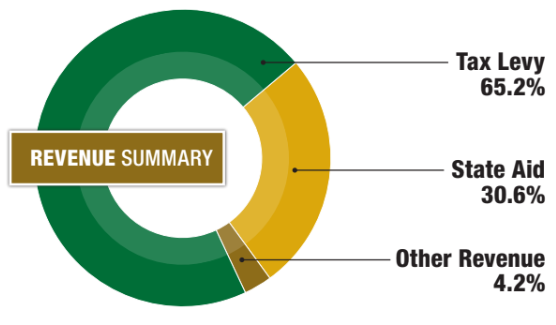
Revenue Summary:
Tax Levy: 65.2%
State Aid: 30.6%
Other Revenue: 4.2%
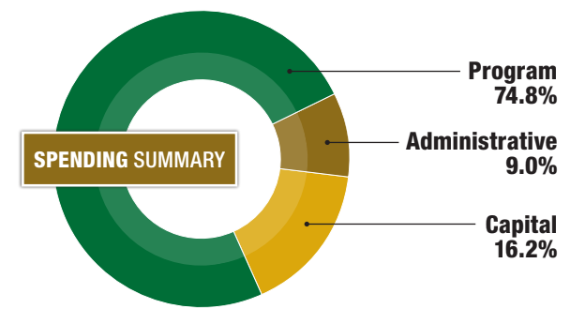
Spending Summary:
Program: 74.8%
Administrative: 9.0%
Capital: 16.2%
Budget Fast Facts
Total
Budget:
$111,254,879
Budget Increase
Compared to 2023-24:
$6,288,033/5.99%
Tax Levy Increase
Compared to 2023-24:
$2,445,197/3.49%
District Profile
Vision Statement
Our vision as a school community is to inspire students and promote personal success.
Mission Statement
Our mission is to build on our commitment to academic excellence with a focus on authentic learning experiences, civic responsibility, and innovative programs. We will accomplish this in an environment that fosters meaningful relationships, honors and affirms the diverse identities and experiences of our students, supports the overall wellness of each student, and promotes continuous improvement in each of the district priority areas: teaching and learning; school environment; service learning and community partnerships; and fiscal capacity and responsibility.
Diversity, Equity and Inclusion Statement
The Fayetteville-Manlius Central School District is committed to creating a collaborative learning environment where all members feel included, respected, valued, and connected by affirming individual identities, fostering relationships, and recognizing diversity as an asset for teaching and learning.
Priority Areas
Teaching and Learning
- Professional Development
- Curriculum and Instruction
- Creativity and Innovation
- Instructional Technology
Read more about our 2024-25 goals and efforts to support Teaching and Learning.

School Environment
- Inclusion
- Character Education and Citizenship
- Wellness
- Safety and Security
Read more about our 2024-25 goals and efforts to important School Environment.
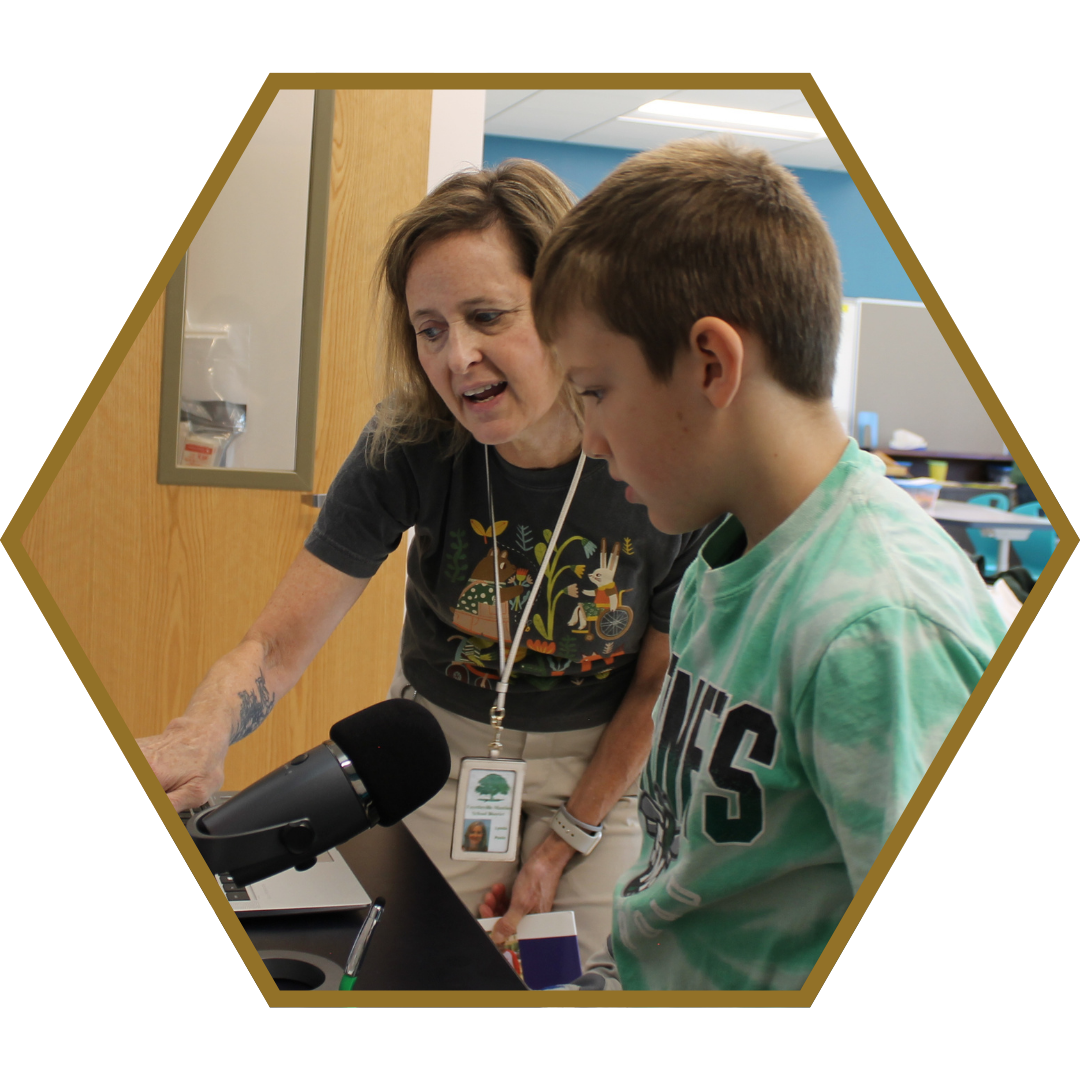
Service Learning and Community Partnerships
- Global and Local Networking
- Community Service Learning
Read more about our 2024-25 goals and efforts with Service Learning and Community Partnerships.

Fiscal Capacity and Responsibility
- Financial Stewardship and Sustainability
- Sound Budgeting and Business Practices
- Facilities Management and Planning
- Technology Infrastructure and Cybersecurity
Read more about our 2024-25 goals and efforts for Fiscal Capacity and Responsibility.
ABOUT US
Full-Time Employees
- 687 Total
- 271 Non-instructional staff
- 416 Instructional staff
- 27 National Board Certified Teachers
- 17 New York State Master Teacher/Teacher Emeriti
Athletics
- 90 Interscholastic Sports Teams
- 1,200 Student-Athletes
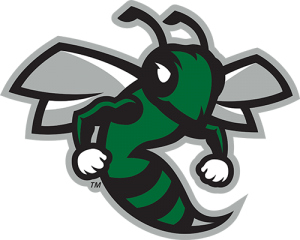
2024-25 Accomplishments
- NYSPHSAA School of Distinction Award
- 100% of varsity
teams earned
Scholar-Athlete
Team Honors
with team GPA
above 90
- 100% of varsity
- 4 league championships
- 6 Section III championships
- 21 seniors committed to play college sports
Music
38% of students in grades 4-12 are involved in the district’s instrumental music program (band/orchestra).
50% of students receiving awards or recognitions at F-M High School’s annual Awards and Recognition Night are students who are involved with the high school music department.
The Fayetteville-Manlius School District was well represented by students who were selected to the following honor ensembles:
- 20 students accepted or alternates to NYSSMA Conference All-State
- 46 students accepted to NYSSMA Junior High Area All-State
- 70 students accepted to OCMEA Junior High All-County
- 51 students accepted to OCMEA Senior High All-County
- 85 students accepted to NYSSMA Senior High Area All-State
Extracurriculars
Ensembles
More than 20 curricular ensembles, including:
- 3 beginning strings
- 3 high school bands
- 2 high school choirs
- 3 high school orchestras
- 4 grades 6-8 middle school bands
- 2 middle school choirs
- 6 grades 5-8 middle school orchestras
- 2 beginning bands
- 3 beginning strings
Extracurricular Groups
There are a number of opportunities for students to be involved in extracurricular musical groups, including the following:
- Jazz bands
- Jazz ensembles
- A cappella groups
- Guitar clubs
- Ukulele clubs
- Chamber orchestras
- Fiddle clubs
- Barbershop
- Swing
- Tri-M Music Honor Society
- High School Musicals
- Middle School Musicals
- Pep band
- Marching band
Board of Education Information: 2024-25
The Fayetteville-Manlius Board of Education is the official policy-making body of the school district. It is responsible for carrying out the laws and regulations pertaining to the education of the community’s children. It adopts school district policy, curriculum and programs of study, approves the hiring of all personnel and establishes the conditions of employment.
In addition, the board has the responsibility of maintaining facilities, establishing an annual budget and setting a tax levy. The school board adopts a proposed operating budget each year at a public meeting. Eligible residents then have the opportunity to vote upon the proposal.
The board includes nine school district residents who are elected by voters to three-year terms in an annual election. Terms are staggered so that three members are elected each year. Board members are not compensated for their work.
The board also includes a non-voting student member who is elected each year by F-M High School students to serve a one-year term. The student, who must be a senior at F-M High School, attends all public meetings and is allowed to participate in all public discussions.
2024-25 Board Membership
- Ann Bersani: Term Expires June 30, 2027
- Jason Catalino: Term Expires June 30, 2026
- Rebecca Cohen: Term Expires June 30, 2026
- Sarah Fitzgerald: Term Expires June 30, 2028
- Cynthia Hefti: Term Expired June 30, 2025
- Marissa Joy Mims: Term Expires June 30, 2027
- Kristen Purcell: Term Expires June 30, 2026
- Daniel Seidberg: Term Expires June 30, 2027
- Daryll Fitch Wheeler: Term Expired June 30, 2025
- Esam Ahmed: Student Board Member
OUR SCHOOLS
Fayetteville-Manlius High School
Grades: 9-12 | Enrollment: 1,380
8201 E. Seneca Tpke., Manlius, NY 13104
Eagle Hill Middle School
Grades: 5-8 | Enrollment: 647
4645 Enders Rd., Manlius, NY 13104
Wellwood Middle School
Grades: 5-8 | Enrollment: 647
700 S. Manlius St., Fayetteville, NY 13066
Enders Road Elementary School
Grades: K-4 | Enrollment: 538
4725 Enders Rd., Manlius, NY 13104
Fayetteville Elementary School
Grades: K-4 | Enrollment: 458
704 S. Manlius St., Fayetteville, NY 13066
Mott Road Elementary School
Grades: K-4 | Enrollment: 449
7173 Mott Rd., Fayetteville, NY 13066
Class of 2024 Profile
Fayetteville-Manlius students go on to do great things locally and globally. Below is a “by-the-numbers” look at the district’s most recent graduating classes. Final data for the Class of 2025 will not be available until fall 2025 and will be shared in the 2025-26 annual report.
Post Graduation Plans
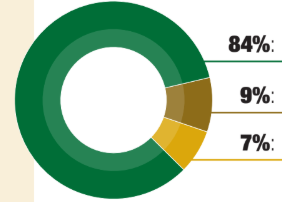
- 84% Four-year colleges/universities
- 9% Two-year colleges
- 7% Other/Trade School/Work/Military
4-Year Graduation Rate
- 2024: 96%
- 2023: 96%
- 2022: 98%
- 2021: 97%
*These numbers include August graduates.
Number of Graduates
- 2024: 346
- 2023: 304
- 2022: 326
- 2021: 332
Diplomas
Advanced Regents
- Class of 2024: 66%
- Class of 2023: 77%
- Class of 2022: 76%
- Class of 2021: 80%
Regents
- Class of 2024: 29%
- Class of 2023: 23%
- Class of 2022: 24%
- Class of 2021: 18%
Local
- Class of 2024: 1%
- Class of 2023: 0%
- Class of 2022: 0%
- Class of 2021: 1%

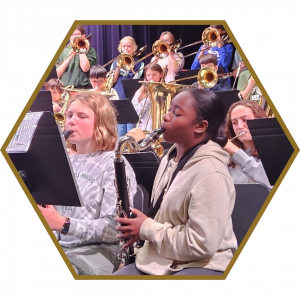
Strategic Plan: Goals and 2024-25 Accomplishments
Teaching and Learning
Teaching and learning is innovative, engaging and rigorous so that students become self-directed learners and achieve academic and personal success.
Provide professional learning for teachers in an educational environment of accelerated change.
- F-M relaunched its Instructional Fair for staff, which the district had not hosted since before the pandemic. The event was held in March 2025 during a staff development day and included more than 70 learning sessions aligned to the district’s strategic plan. Session topics ranged from diversity, equity and inclusion to artificial intelligence to the science of reading. Representatives from tech companies and local businesses that work to support students’ learning were also in attendance. The sessions were facilitated by F-M K-12 teachers, as well as outside presenters from OCM BOCES, local colleges and universities, and other vendors. The event was so successful, the district plans to continue hosting its Instructional Fair bi-annualy and is planning a mini fair for the spring.
Clearly communicate and implement a plan for integrating personalized learning paths into the district.
- The District Curriculum Council developed F-M’s Portrait of a Learner. It coincided with the development of New York State’s Portrait of a Graduate, which highlights the skills necessary for students to succeed in school and beyond. Throughout the year, F-M’s department leaders worked to identify the skills necessary to create a personalized learning path for each K-12 student in the district. The group consulted with members of F-M High School’s Student Council for feedback, which was used to develop the skills and competencies that comprise F-M’s Portrait of a Learner. Moving forward, the District Curriculum Council will identify models for staff to build K-12 personalized learning pathways.
Identify academic areas in need of additional support and develop plans to address them.
- Following a year-long review of F-M’s literacy program, the district piloted two literacy programs in response to teachers’ requests for better literacy tools and more alignment between and across grade levels. A group of 28 classrooms, representing grades K-6 across all of F-M’s elementary and middle schools, piloted Benchmark Advance and HMH Into Reading. The piloted programs aim to reinforce students’ literacy skills using evidence-based practices developed over decades of research, also known as the “science of reading,” and align with the New York State learning standards for English Language Arts. The district monitored student growth throughout the year, analyzed assessments, and reviewed student, teacher and parent feedback. An analysis of the data and feedback showed that Benchmark Advance outperformed the other pilot program in K-4 classrooms and was selected as F-M’s new literacy program to be implemented in all elementary classrooms starting in Sept. 2025. While Benchmark Advance was not selected for grades 5 and 6, the curriculum, instruction, and assessments were refreshed to align with the new K-4 program.
- STAR universal screening and assessment data continued to be used at the middle school level to help evaluate students’ progress in reading and math. The data was used in conjunction with other tools and strategies to help identify students in need of extra support/interventions, track student growth, and inform instruction.
Refine curricula to address revised New York State and national learning standards.
- To meet New York State Computer Science and Digital Literacy Standards, all F-M students received instruction in the areas of cybersecurity, networking and systems designs, digital literacy, computational thinking, and impacts of computing. Eagle Hill Middle School partnered with the McMahon Ryan Child Advocacy Center to participate in their Internet Safety program. Sixth-grade students attended a presentation about what it means to be a responsible “digital citizen.” The program focuses on building students’ understanding that certain types of communication (strong language, hurtful messages, or inappropriate pictures) can have long-lasting consequences, ranging from social impacts to school disciplinary action to criminal charges.
Expand opportunities that promote student engagement, educational equity and personalization of instruction.
- An 8:1:1 special education classroom for grades 2-4 was added at Mott Road Elementary School to better meet student needs. An 8:1:1 special education class refers to a classroom setting with a ratio of eight students, one teacher, and one paraprofessional. It is designed for students with educational needs that require a high degree of individualized and personalized behavioral support and specially designed academic instruction. F-M’s 8:1:1 program often incorporates opportunities for students to participate in general education classes or activities with appropriate support and modifications. The district also expanded its special education services at the elementary level by implementing a new 12:1:1 program at Fayetteville Elementary School for grades K-1.
- Students at Fayetteville Elementary School, Eagle Hill and Wellwood middle schools, and F-M High School made their voices heard by participating in “On Tuesdays We Vote.” This civic engagement initiative, aimed at cultivating informed and active citizens, gave students the opportunity to learn about democratic processes and express their opinions. Students voted on topics such as technology use, the electoral college, lunch options, start times, and spirit weeks.
- Math teachers at Wellwood Middle School began applying research-based strategies from Building Thinking Classrooms, an educational approach that promotes student engagement and deeper mathematical thinking and learning.
Continue the integration of the New York State Computer Science and Digital Fluency learning standards and innovative instructional technology practices, via work through Tri-State Consortium and the Technology Committee.
- The district began work to develop elementary, middle, and high school benchmarks to assess students’ technology skills. The benchmarks will be used to ensure students are proficient in utilizing various technological tools, effectively navigating digital platforms, and demonstrating responsible digital citizenship.
- A Science, Technology, Engineering, Arts and Mathematics (STEAM) Team was developed at F-M High School. The team, comprised of high school science, technology, engineering, art, and math teachers, is dedicated to evaluating and implementing pathways to integrate instructional technology across multiple subjects and courses.
School Environment
The school environment is safe and secure and students are equipped with the skills to confidently navigate their complex lives.
Leveraging data from a variety of sources across the district, identify at least one area of focus (academic, social and/or emotional). Develop implementation plan(s) to show improvement in those area(s).
- As part of the district’s Multi-Tiered System of Supports (MTSS), Mott Road Elementary School implemented the Brainstorming Educational Strategies Team (BEST) approach. The benefits included a more streamlined, efficient, and thorough process to meet student needs by utilizing targeted interventions within a data tracking system to monitor progress, and allow for increased teacher voice. There was a significant and positive impact on student academic, social-emotional and behavioral progress. Twenty-two students received personalized, supplemental support through the BEST program at Mott Road.
- The BEST approach was enhanced and improved at Enders Road Elementary School for its second year. Based on survey data from instructional staff, adjustments were made to processes and professional learning opportunities to ensure consistent understanding of the BEST purpose and procedures. More than 50 students received personalized supplemental academic, and social-emotional support through the BEST program at Enders Road.
- F-M brought back its community Big Read for a third year in an effort to better support its students and the community by addressing “toxic achievement culture” and redefining success. F-M community and staff members were invited to read “Never Enough: When Achievement Culture Becomes Toxic and What We Can Do About It,” and attend four events throughout the year. Guided group conversations focused on key points from the book, how to address the pressure students feel to succeed, and the toll it can take on students’ mental and emotional well-being. Panelists also shared practical advice, stories, and insight on how to pursue success while staying true to what matters to you.
Using the input and feedback from the DEI Committee and Mental Health Task Force, develop a plan to implement at least one initiative in the upcoming year.
- To foster an emotionally and socially safe and positive environment for a diverse group of students at lunch and recess, Enders Road Elementary School piloted the Comfortable Cafeteria and Refreshing Recess programs at the third-grade level. During a six-week period, the programs focused on building connections, encouraging play and friendships, conflict resolution, and promoting positive behavior and emotions.
Assess the effectiveness of the social-emotional learning, counseling and mental health services currently in place to support the development of the whole child.
- F-M’s therapy dog program was expanded due to its successful impact, providing social-emotional support to students and staff. The number of certified therapy dogs grew to 20, with at least one in each school building. Therapy dogs are known to reduce stress levels, improve attendance, and contribute to cognitive development in schools.
- In an effort to provide targeted mental health support for students, the district’s mental health educator began meeting with junior varsity and varsity student-athletes each athletic season to discuss topics such as stress management, performance anxiety, and overall mental well-being. The sessions are designed to help students build healthy coping strategies, strengthen resilience, and promote a positive balance between athletics, academics, and personal life.
- Building crisis teams meet annually to review protocols and ensure crisis readiness. This collaboration among counselors, staff, and administrators helps the district assess its preparedness and ensure it can effectively support students, staff, and families in the event of a crisis.
Develop collaborative learning spaces and schedules that support student inquiry.
- The Community-Wide Dialogue program was restructured to foster collaboration between Eagle Hill and Wellwood middle school students. The program provides students the opportunity to reflect on their own identities and cultures, affirm other’s identities and cultures, and celebrate diversity. F-M High School students were also invited to join as “adult allies” to enrich discussions by offering their perspective on districtwide topics.
Monitor board-approved recommendations from the district Safety and Security Task Force.
- In late June, work began to address safety and security upgrades at every school building. The enhancements included upgrades to lighting, the public address system, security cameras, and the keycard access system. The upgrades are part of the $15.4 million capital project, approved by voters in May 2023.
- The district maintained its School Information Resource Officer (SIRO) and Special Patrol Officer (SPO) program, which includes three SIROs and four SPOs so that each school campus has at least one assigned officer. Of the seven officers working with the district, the district’s SIROs are active duty Town of Manlius police officers assigned to serve the school district, and the four special patrol officers are retired law enforcement professionals hired by the town to serve as peace officers for the district.

Service Learning and Community Partnerships
Educational opportunities extend beyond the classroom to enrich learning, develop student awareness of the global community and promote intellectual and civic engagement.
Participate in Tri-State Consortium and AASA Learning 2025 National Collaborative to network with state and national educators and remain current with future-focused educational practices.
- To address recommendations from Tri-State Consortium, the district began work to improve its use of instructional technology to benefit a broad range of learners. The district expanded its use of assistive technology for special education students, transitioning from human readers and scribes to text-to-speech and speech-to-text technologies. This allows special education students to spend more time in general education classrooms and provides more opportunities for independence.
- The district pursued efforts to enhance professional learning opportunities for staff related to instructional technology in response to Tri-State Consortium recommendations. The district started developing an online library of resources for instructional staff to introduce them to and work with artificial intelligence (AI). Resources are available to meet the various needs and skill levels of F-M’s instructional staff.
Develop student service learning opportunities and community partnerships that extend classroom learning and support personal and social growth.
- Wellwood Middle School worked with Clear Path for Veterans to host a school-wide service learning initiative. Four quarterly events brought students and staff together to explore themes like teamwork, courage, and perseverance. The partnership also inspired a year-long series of student-led collection events which raised $4,500 for the organization.
- Students in F-M High School’s Advanced Photography 4 class gained practical, hands-on experience by partnering with six local small businesses. Students were able to build their professional portfolios while businesses received high quality images at no cost.
- Wellwood students in Family and Consumer Science classes competed to develop and cook their own unique waffle recipes. The students’ creations were served to a panel of judges, including Adam Gold who is the co-founder and owner of Funk n’ Waffles in Syracuse.
- Eagle Hill Middle School students in grades 5 and 6 participated in King Arthur Baking Company’s “Bake for Good” program, which encouraged students to share baked goods as an act of kindness. After a live demonstration, students used kits to bake two loaves of bread: one for their family and one to donate. 167 loaves were donated to the Syracuse Rescue Mission.
- F-M High School’s Patriot Club served breakfast to more than 500 veterans at the 17th annual CNY Veterans Expo in Syracuse. The club also held a cupcake fundraiser, donating $500 to the Disabled American Veterans (DAV), a non-profit organization that connects U.S. military veterans and their families with healthcare, disability, employment, education, and financial resources and support.
- F-M High School students hosted the annual Dance Marathon fundraiser raising $145,021.39 for Camp Good Days and Special Times. The not-for-profit organization provides a summer camp experience to children whose lives have been impacted by cancer and sickle cell anemia. The money raised will help send 181 kids to camp.
- Fayetteville Elementary School third graders worked with a Feldmeier Equipment engineer to compete in an engineering challenge. The students worked together in teams to build wind-resistant structures, learning how people can reduce impact from natural hazards through design.
- Mott Road Elementary School students and staff gathered 1,500 pairs of socks during a “Socktober Drive.” The new socks were donated to We Rise Above the Streets, a recovery outreach organization for the homeless population in Syracuse.
- F-M High School’s Red Cross Club hosted an “Emergency Night,” giving elementary-aged students the opportunity to learn about a range of important topics at different stations. Students learned about emergency vehicles by exploring them, dental health, regulating emotions, and more.

Fiscal Capacity and Responsibility
The district’s annual operating budget supports educational excellence and quality facilities while being sensitive to the taxpayers of the district.
Develop and communicate prioritized and time-phased plan for district facilities and other major expenditure needs.
- The long-range facilities plan helps guide the district in its infrastructure maintenance and development, strategically prioritizing equipment replacement and anticipated facilities needs. The plan is primarily based on the results of the most recent Building Condition Survey, which was conducted in 2023, and is used to develop future capital projects. Information about capital project work, both ongoing and anticipated, is shared with district stakeholders via printed publications and on the district website.
- The district maintains vehicle and bus replacement plans to ensure the timely replacement of vehicles. The vehicle and bus replacement plans are discussed in detail during the annual budget planning process. Information is shared in the district’s annual budget communications, including the budget newsletter and on the district website.
Maintain a strong financial position through the optimization of state aid and other revenues along with utilizing cost-effective business practices.
- The financial position of the district continued to improve with additional revenue from New York State in the form of Foundation Aid and BOCES Aid. The district has historically maintained a fiscally responsible approach with these types of additional funds by planning ahead and saving incrementally for the future. This approach is used to mitigate the financial impact on the district’s annual operating budget when major, non-recurring or unforeseen expenditures occur. Reserve funds can also reduce the future impact on taxpayers and protect staffing levels, programs and services for F-M students in case of economic downturns or reductions in state aid funding.
- The district has consistently maintained a strong AA stable bond rating, which means the district is considered financially sound. A strong credit rating enables the district to receive lower interest rates on future financial borrowing, ultimately saving the district and taxpayers money.
Complete capital improvement projects on time and within budget to improve learning spaces, building infrastructure, building security, and accessibility.
- Construction at F-M High School surpassed the halfway mark. The work is part of the $52 million capital project, which was approved by voters in December 2021. The primary focus of the project is to modernize and expand the school to meet contemporary teaching and learning needs. Work that was completed includes: main office suite consolidation in House 1, a new nurse’s office, kitchen upgrades, art wing and library media center roof replacements, photography classroom, staff lounge, wellness center and auxiliary gym renovations.
- Work began to address critical aging infrastructure needs and safety and security upgrades as part of the $15.4 million capital project approved by voters in May 2024. A partial roof replacement was completed at the F-M District Office during spring 2025. The project also includes partial roof replacements at F-M High School and Wellwood and Eagle Hill middle schools, safety and security upgrades across all school district buildings, and heating, ventilation and air conditioning (HVAC) control upgrades at Fayetteville Elementary School, F-M High School, Support Services Maintenance Building, Transportation Center and Conference Center. Project work at the school buildings began in late June.
Monitor the long-range facilities plan to ensure that district facilities are responsive to contemporary teaching and learning needs and support a productive, safe, and secure work environment for all students and employees.
- Based on the most recent Building Condition Survey, along with requests and needs provided by district administrators and building level leaders, the district prioritized projects that included work to improve heating and ventilation systems, replace roofing, enhance security, address programmatic needs, update fire alarm and emergency communications systems, and other needs.
- The district continues to explore how to include electric buses and related infrastructure upgrades into its long-range plan in response to the New York State electric bus mandate. Starting July 1, 2027, all school bus purchases must be electric and by July 1, 2035, all diesel- fueled school buses must be replaced with electric buses.
Maintain district technology infrastructure, including privacy and cybersecurity protection systems.
- Upgrades to telecommunication connections from legacy copper to fiber optic cabling were completed to improve network quality and reliability. Wireless and networking infrastructure upgrades at Eagle Hill and Wellwood middle schools were also completed to ensure network reliability for students and staff.
Planning for Our Future
Expanding, improving, and unifying F-M High School.

The print version of this Annual Report was produced in cooperation with Capital Region BOCES Engagement & Development Services.